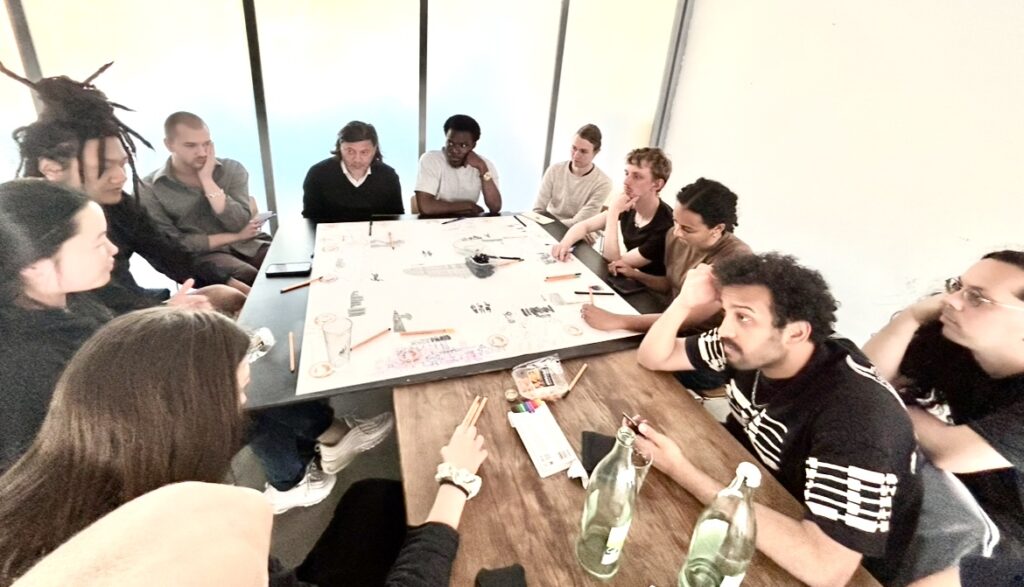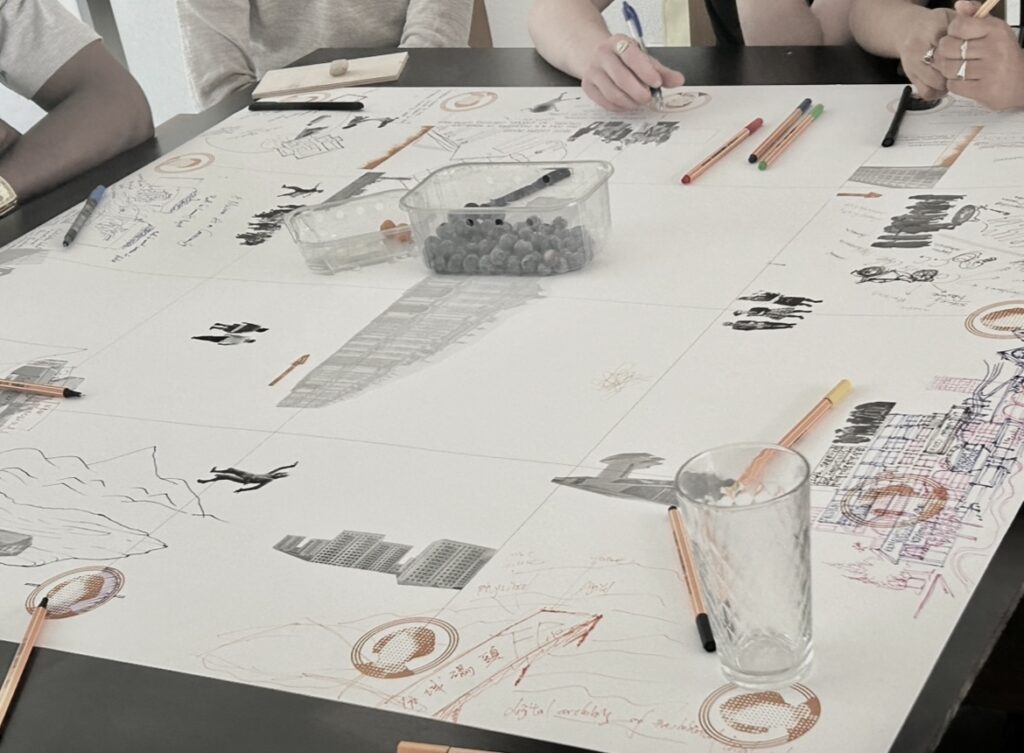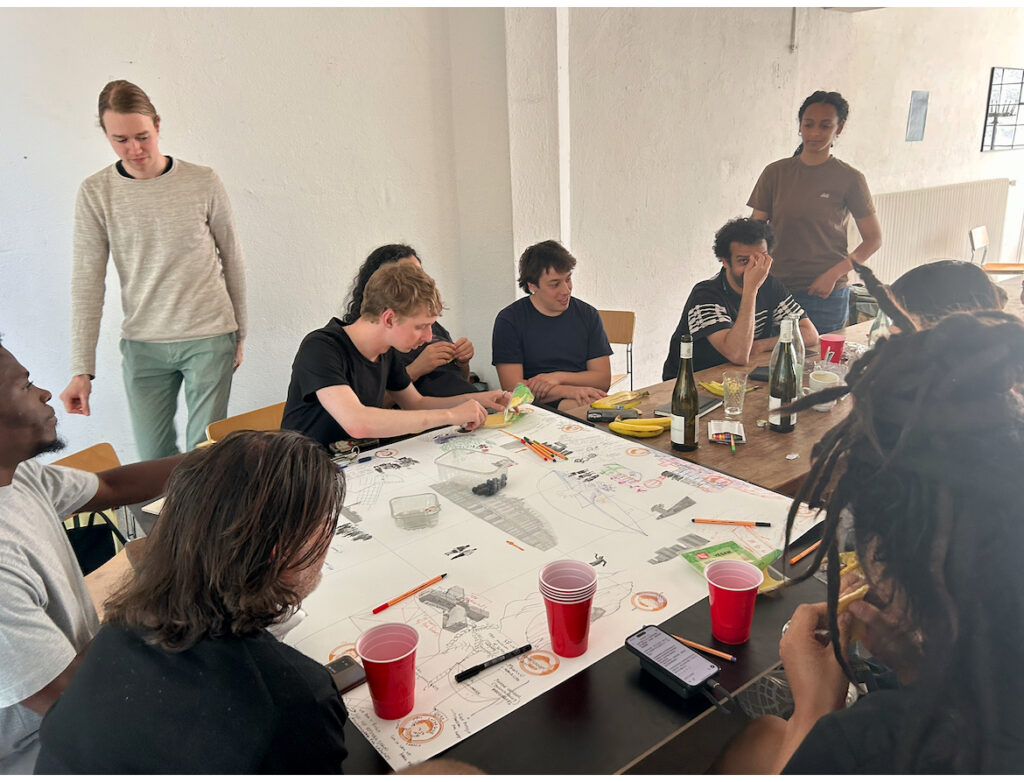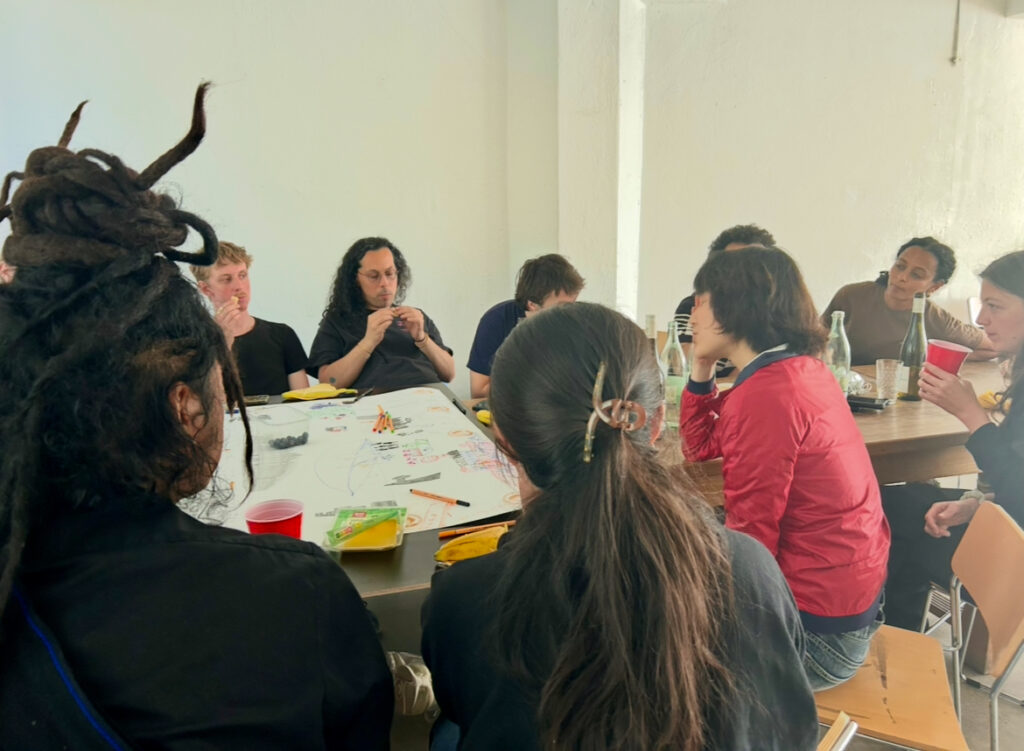The Visual Assembly at Städelschule in Frankfurt took place Staatliche Hochschule für Bildende Künste – Städelschule. It was organized in collaboration with Professor Philippe Pirotte, who leads a class of curators and artists. Interestingly, the art professionals drew much less than the children generaly do. We mostly talked, but the ideas generated by participants could easily serve as the foundation for an entire flotilla of museums.
We began with the concept that there are 4,500 abandoned ships around the world — each of which could be turned into a museum.
Imagine 4,500 abandoned ships — waste polluting the world’s oceans — transformed into real Museums of Care. Pulled ashore, they become treasures: giant metal structures with spacious rooms, entrances, exits, and public areas. Surrounding these spaces, there could be playgrounds or parks in a thousand different countries. In total, there are 159 countries, including Palestine (if considered a country) and the Vatican (if it agrees), that could each host such a museum.
What an infinite number of unexpected ideas for museums emerged in just two hours of work with 15 people!
I’ll list here some of the ideas that stood out to me the most. More importantly, the majority of participants weren’t suggesting building anything new. On the contrary — they were pointing to what’s missing in most museums, or in the museum-industrial complex as a whole.
The problems they raised could be summarized like this:
- What if the museum wasn’t about preserving, glorifying, or managing “important” content — idealized heroes who are always tied to power?
- What if instead it focused on preserving and caring for ordinary lives — the very essence of who we are?
- What if we stopped building new structures and began restoring what’s been lost — including nature itself?
- What if the museum centered on people, using already-existing life as the foundation — not as raw content for curation, but as the structure of the museum itself?
What if the museum were about that?
Democratizing the Archive
Imagine a museum for the democratization of archives — made of simple, useful tools to collect and exhibit people’s home photos: images documenting everyday life. In many parts of the world, preserving even the most important family relics — like photo albums — is a challenge due to technological failures, hurricanes, fires, or displacement.
A young curator from Sudan reflected on those who have lost not only their homes, but also their family photos — memories of how children grew up, of how elders aged. She imagined a mobile museum: a bus with a scanner, traveling from village to village, collecting and preserving anything people wished to share.
In Saint Vincent and the Grenadines, where we often work, the aftermath of Hurricane Beryl showed something unexpected: what people mourned first was the loss of family records. In wealthy Los Angeles, both celebrities and ordinary residents recalled not their valuables, but their photo albums.
Today, many artists use vernacular photography in conceptual projects. While this practice can be meaningful, the original creators likely saw these images as intimate, deeply personal records.
What would it mean to create public museums filled with such photos? Not harvested by tech giants to train AI, but cared for and shared with consent — as collective memory, rooted in family, friendship, and place.
The Youth Museum
A museum not designed to archive the past, but to celebrate youth culture. This museum wouldn’t be tied to a building — it could be mobile, appearing in public spaces as flags strung across streets or pop-up exhibitions. Comics, street art, digital platforms — all become part of its medium.
What about a gallery of heroes and superheroes? What else could be part of such a museum?
Museum as a Restoration Project
Imagine a ship equipped with tools, traveling from country to country — not to build, but to restore. It values what progress forgets: mountains, rivers, forests, birds, butterflies. Everything we destroy to create something “new.”
This museum is devoted to preserving, repairing, and reclaiming.
It is a problem-solving structure, dedicated to restoring places where nature was sacrificed for meaningless development — abandoned buildings, toxic mines, industrial ruins.
- What would such a museum look like?
- How could a project like this be organized and sustained?
Museum of Wellbeing
What if this museum were also an economic intervention — reclaiming privatized, commercialized urban spaces and transforming them into hubs of public life?
Imagine a Museum of Public Welfare that occupies abandoned buildings, offering free housing, care, and community. Every city already has plenty of such spaces. Starting in the city center, it could expand outward — creating truly accessible urban spaces and challenging the real estate market. Who would pay exorbitant rent if they could live in a museum?
What tools would such a museum need to make cities livable, inclusive, and ecological?
At night, museums sit empty — guarded and climate-controlled. Meanwhile, people sleep outside under cardboard and thin blankets. In many cultures, churches and monasteries offered refuge as sacred duty. We’ve forgotten this tradition.
What if the museum became a shelter — not symbolically, but physically? A space for protection, dignity, mutual care. A public space where culture and life are no longer separate.
A Carnival Museum
A museum that might need nothing more than a café — or just a bar.
But entry comes with a condition: you must invent a mask and become someone else — with new clothes, a new story, perhaps a real mask.
You stay as long as your character lasts — speaking, listening, improvising.
A space for imagined futures. A carnival — the oldest, most universal form of freedom.
So many museums were imagined that I probably won’t be able to describe them all. It would take an entire book — a book of imaginary museums.
But here are a few more to spark your imagination:
- A Museum of Gossip
- A Museum of Immortality
- A Museum of Seeds
- A Museum of Uprising
- A Museum of Laziness
- A Museum of the Flying Ship
It felt like the Assembly could go on forever — ideas flowed like a feast, with each new voice bringing something unexpected.
That was especially striking because, in reality, most museums around the world function in exactly the same way.
So where do all these ideas go?
And maybe — just maybe — we could actually bring some of them to life.







Google Map: Unites of Care — Imaginary and Real. You can add your Unites of Care — along with descriptions, drawings, and photos.





